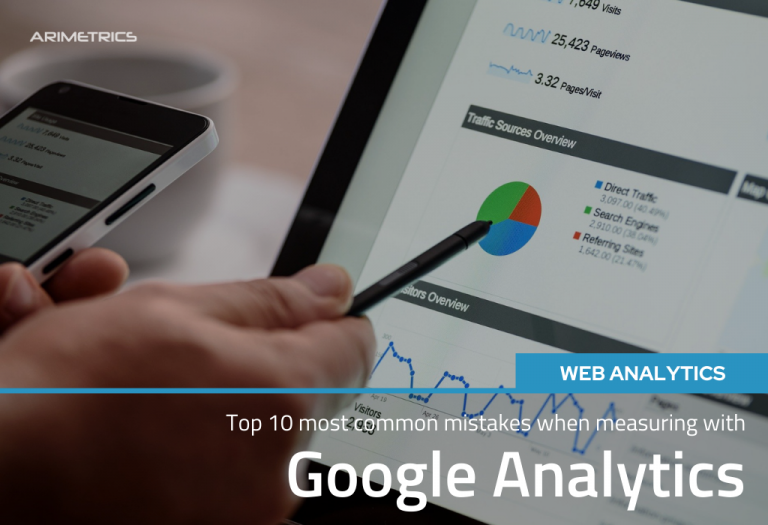Optimizing a Google Ads campaign can be done in many ways; you can do it from the tool itself according to conversion criteria, average position, CTR, adjusting CPC… going through the use of competition analysis tools and search for new keywords to attack or ads to write.
Doing all this the results of your campaigns will improve, but they will undoubtedly do much more if you support your optimization in the use of web analytics tools that provide you with all the necessary data to measure and improve everything that happened in the landings or landing pages where your ads direct users.
Table of Contents
“Web analytics is the perfect complement to a Google Ads campaign”
In this post we will see what are the main indicators of web analytics to take into account when performing a landing analysis, how to analyze the behavior of users to improve your Ads campaigns, and some useful tips to keep in mind for any web analyst.
1. Top Web Analytics Indicators You Should Know
There are 4 basic Google Analytics metrics or indicators that you should look at when analyzing a landing page (in order of importance):
1.1. Conversions/Conversion Rate
As I always say in my articles, the epicenter of web analytics. It is the indicator that will tell you if you are doing things well or not,whether or not you are fulfilling the goal you have set as a conversion. It is almost always chosen as one of the KPIs or key performance indicators in any measurement plan.
There are two types, “microconversion” and “macroconversion”; simply microconversion is the conversion that does not directly entail an income, that is, it would be an example of microconversion a form submission, a subscription … and macroconversion therefore, a sale or transaction, or the agreement and closing of a budget.
As you can imagine, it is the most important indicator and on which all your actions must revolve. It’s the most important optimization criterion you should keep in mind.
1.2. Bounce Rate
The indicator to go to if for whatever reason we could not measure the achievement of objectives. The number 2 of web analytics.
The bounce rate is simply “of all the users who arrive at the landing, how many say – this page I do not like, I leave“, and therefore do not navigate through it. Taken to the physical terrain it would be like a person who sets foot in a store and then leaves.
It is usually considered good up to 50% approx, although it depends a lot on the sector, the type of business, and the website itself among other factors. A website of prior appointment for the doctor will obviously tend to have a very low rebound, within the health sector it is likely that 50% is considered an unfavorable result (it would have to be analyzed).
In the face of web analytics, this indicator must tend to decrease it as much as possible. Can it convert your landing despite having a high bounce? -Yes, but the lower the value of this indicator will mean that the first impression that users have about your landing is good and the browsing experience will improve in the face of Google Ads.
“There is only one chance to make a good first impression”
1.3. Length of stay, or average duration of session
This indicator forms “the trinity” of basic analytics as far as Google Ads is concerned. We already know whether or not the goals are met and how many users access to browse, scan and interact within it, but how long are they there? Are they interested in what they are seeing or do they decide to interact but leave soon?
The time spent on the page as well as the bounce rate directly affect the “landing page experience” indicator that takes into account the quality level of the keywords in Adwords. You can check it in the Adwords interface in the “keywords” tab in the “Status” column as you can see in the image:
Therefore, this indicator will directly affect the positioning of your ads; the longer they stay and interact, it will be like telling Google, look how they like my landing, your quality level will increase and your ads will have a higher Ad Rank, which will reduce the cost of being up there fighting for the top positions.
1.4. Number of page views per session
This indicator could be called “sub-indicator” since by itself it does not tell us anything in the face of Google Ads, we need to know if it converts or not or at least if it has browsed and how long.
The importance of this indicator is that it will reveal whether the landing is good enough on its own to convert,or users need to browse more and look for more information about you to get to provide you with their trust.
Normally it is usually thought “the more pages they see per session the better”, and yes, in an organic search or in a referral effectively, it is convenient that they navigate the more and in more pages the better, but when we talk about Ads and landings we must focus on just the opposite.
“The goal is for the landing to be so good that it converts on its own”
The closer you get to 1 this value, it will mean that the landing is a success… as long as it ends up converting (a landing that you like but that does not convince is useless).
Within Google Analytics these are 4 indicators are the ones you have to keep in mind when analyzing the landings but.
2. Is there a way to analyze what is happening on my website to improve my campaign?
Of course, and for this despite the fact that Google Analytics has its “behavior” section where several aspects related to the indicators that we have seen among others can be analyzed, I recommend the use of specific tools to analyze landings.
An example of a tool is Lucky Orange; records users’ sessions in such a way that you no longer just see data in tables and graphs, but you can see exactly what they’ve done inside the landing. You also have the option to view live sessions as well as heat maps, but what fascinates me most about the tool are the session recordings.
You have the option of being able to see the movement trail of the mouse as you can see in the image, to get to identify movement patterns, and heat maps that are really useful for making decisions regarding the usability and design of your website.
“In the face of web analytics and the improvement of the landings of your Google Ads campaigns, it is essential that you know what happens when a user arrives at the landing”
The most important indicators you should look at are:
- Clicks
- Mouse movements
- Time of stay
- Sequence of pages
Based on them, the task of the web analyst is as always the search for patterns and the answer to questions such as “are clicks and movements concentrated somewhere in the landing?, do they click on places where there are no links?, do they stay long on a page or navigate?, is there any pattern in navigation or mouse movement?, What if there is, is there a page that generates rejection?, is there a mathematical correlation between any relevant variable? etc.
You can also segment by browser, device type, or location, and it has a pretty useful tag filter if you want to segment even more in your analytics.
Then, it is a matter of collecting all the data and starting to segment and work with them until you find the keys and the identification of all the possible aspects of improvement of that landing.
On live views, it is useful in cases of live contact with a user or to analyze the immediate impact of a change made, but it is not something that a priori is essential for the improvement of a landing page for Google Ads; a web analyst works mainly with processed and recorded data, segmenting and analyzing.
3. Important tips when performing a Web Analysis
To finish the post, I indicate 5 essential tips that every web analytics service must offer to make it infallible:
- When you have doubts about how to choose KPIs, ask yourself what objective what is being done has. A KPI cannot exist without a goal that defines it.
- Respects the reliability and validity of measuring instruments and data.
- Never work with aggregated data, always segment; the more you segment the data, the better.
- Difference between what the data says and what you say; as professional as an opinion may be, data is data.
- Intelligence behind data: don’t just collect, interpret and present; you can take out a lot of information and make the data speak by performing statistical analyses that will clarify many doubts and provide you with keys to success. The data is always quiet, it’s you who has to make them talk.
I hope you liked the post and it helps you to improve your web analytics and your Adwords campaigns, if so, share it!






